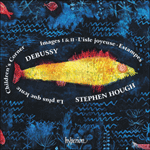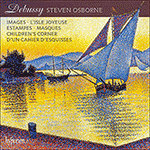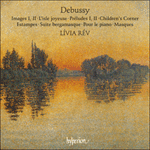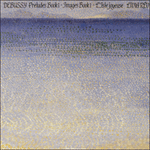
Welcome to Hyperion Records, a British classical label devoted to presenting high-quality recordings of music of all styles and from all periods from the twelfth century to the twenty-first.
Hyperion offers both CDs, and downloads in a number of formats. The site is also available in several languages.
Please use the dropdown buttons to set your preferred options, or use the checkbox to accept the defaults.

The other external influence on the piece often quoted is Watteau’s painting L’embarquement pour Cythère. A letter from Debussy published only in 2003 shows this to have been true up to a point. An organist had written, asking for advice on how to play his music. Typically, he refused to give any such blanket testimony but, after suggesting, with the merest whiff of vinegar, that the title might possibly be a help, Debussy went on to say that ‘there’s also a bit of L’embarquement pour Cythère with less melancholy than in Watteau: you find the masks of the commedia dell’arte, young women singing and dancing; everything culminating in the glory of the setting sun’. While not necessarily relevant to our enjoyment of the piece, Debussy’s awareness of the painting’s melancholy deserves to be saluted: as Edward Lucie-Smith has pointed out, the title would more correctly be ‘Departure from the Isle of Cythera’ and ‘the three pairs of lovers … represent in fact different aspects of the same couple and the same relationship … the third pair, moving off, look back regretfully. One must nevertheless admit that the smiling ambiguity which allowed a radical misrepresentation of its subject-matter is a large part of the picture’s charm …’
Certainly there is ambiguity in the opening trill and cadenza, based on the whole-tone scale that had served for the darker moments in Pelléas et Mélisande. These recur twice, the second time on the last page where they are absorbed into the passionate waltz tune. The work’s extraordinary energy is expressed throughout in dotted rhythms, rippling triplets, sounding trumpets, and a final Lisztian gesture that takes in the whole keyboard. No regrets here.
from notes by Roger Nichols © 2017
L’autre influence extérieure souvent citée à propos de cette pièce est le tableau de Watteau L’embarquement pour Cythère. Une lettre de Debussy publiée seulement en 2003 montre que c’est vrai jusqu’à un certain point. Un organiste lui avait écrit pour lui demander conseil sur la manière de jouer sa musique. Fidèle à lui même, il refusa d’accorder la moindre indication mais suggéra dans la foulée et non sans un soupçon d’ironie que le titre contenait peut-être un indice; Debussy poursuivit: «C’est un peu aussi L’embarquement pour Cythère avec moins de mélancolie que dans Watteau: on y rencontre des masques de la comédie italienne, des jeunes femmes chantant et dansant; tout se terminant dans la gloire du soleil couchant.» Sans être nécessairement utile pour apprécier cette pièce, la prise de conscience par Debussy de la mélancolie du tableau mérite d’être saluée: comme l’a souligné Edward Lucie-Smith, le titre «Départ de l’île de Cythère» serait plus correct et « les trois couples d’amoureux … représentent en fait différents aspects du même couple et les mêmes relations … le troisième couple, qui s’en va, regarde derrière lui avec regret. Néanmoins, il faut admettre que l’ambiguïté souriante qui a donné lieu à une présentation déformée de son sujet fait en grande partie le charme du tableau …»
Il y a assurément une certaine ambiguïté dans le trille initial et la cadence, basés sur la gamme par tons qui avait servi aux moments les plus sombres dans Pelléas et Mélisande. Ils reviennent deux fois, la seconde à la dernière page où ils sont absorbés dans un air de valse passionné. L’extraordinaire énergie de cette œuvre s’exprime du début à la fin en rythmes pointés, en cascades de triolets, en effets de trompette, et dans un geste final lisztien qui couvre la totalité du clavier. Sans regret.
extrait des notes rédigées par Roger Nichols © 2017
Français: Marie-Stella Pâris
Häufig wird auch auf eine anderen Inspirationsquelle hingewiesen: Watteaus Gemälde L’embarquement pour Cythère. Erst in 2003 wurde ein Brief Debussys veröffentlicht, der das sogar in gewisser Weise bestätigt. Ein Organist hatte ihn brieflich um Tipps gebeten, wie er seine Musik spielen sollte. Es widerstrebte Debussy zwar, eine schlichte Gebrauchsanweisung zu liefern. Doch nachdem er den etwas bissigen Hinweis gegeben hatte, dass der Titel vielleicht ganz nützlich sein könnte, fuhr er fort: „Es liegt auch etwas vom Embarquement pour Cythère darin, nur weniger melancholisch als bei Watteau: Hier sieht man die Masken der Commedia dell’arte, junge Frauen, die tanzen und singen; und alles mündet in einen herrlichen Sonnenuntergang.“ Es mag nicht unbedingt zum Verständnis des Stücks beitragen, doch spricht es für Debussys Kunstverstand, dass er die Melancholie des Gemäldes würdigt. Edward Lucie-Smith wies darauf hin, dass der Titel eigentlich „Abfahrt von Kythera“ lauten müsste: „Die drei Liebespaare … stehen in Wirklichkeit für drei verschiedene Aspekte desselben Liebespaars und derselben Beziehung … Das dritte Paar blickt im Fortgehen wehmütig zurück. Freilich muss man auch einräumen, dass die lächelnde Mehrdeutigkeit, die ein solches Missverstehen des Bildgegenstandes erst möglich machte, großen Anteil am Charme des Bildes hat …“ Mehrdeutig sind bereits der Triller und die Kadenz ganz zu Beginn. Sie basieren auf der Ganztonleiter, die schon in den unheimlichen Momenten in Pelléas et Mélisande zum Einsatz kam. Zweimal kehren sie wieder, zuletzt auf der letzten Seite, wo sie in den leidenschaftlichen Walzerwirbel hineingesogen werden. Die außerordentliche Kraft des Werks zeigt sich durchweg in punktierten Rhythmen, wirbelnden Triolen, Trompetenrufen und einer Schlussgeste nach Liszt’scher Manier, die die gesamte Breite der Klaviatur beansprucht. Von Wehmut keine Spur.
aus dem Begleittext von Roger Nichols © 2017
Deutsch: Friedrich Sprondel
 Debussy: Piano Music Debussy: Piano MusicAny release from Stephen Hough is a keenly awaited event, and this recital of some of Debussy’s best-loved works for solo piano set the bar high in the centenary year of the composer’s death.» More |
 Debussy: Piano Music Debussy: Piano MusicSteven Osborne returns to the music of Debussy, delivering masterly accounts of three major piano works.» More |
 Debussy: Piano Music Debussy: Piano Music‘Distinctive and distinguished performances’ (BBC Music Magazine) ‘Very distinguished playing indeed and must be strongly recommended’ (The Penguin Guide to Compact Discs)» More |
 Debussy: Preludes Book 1 Debussy: Preludes Book 1 |

